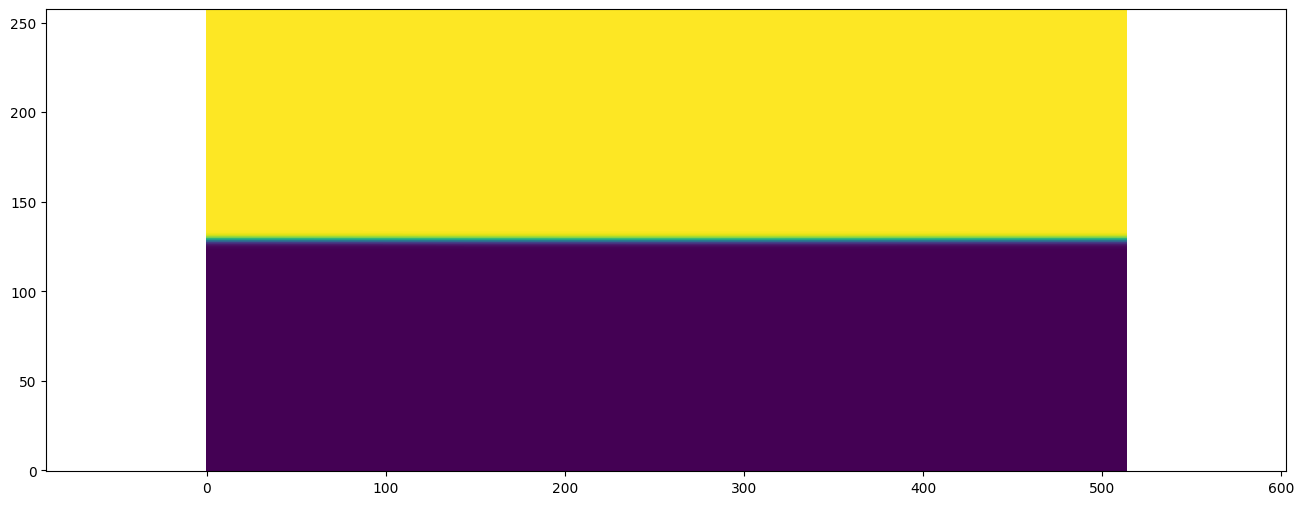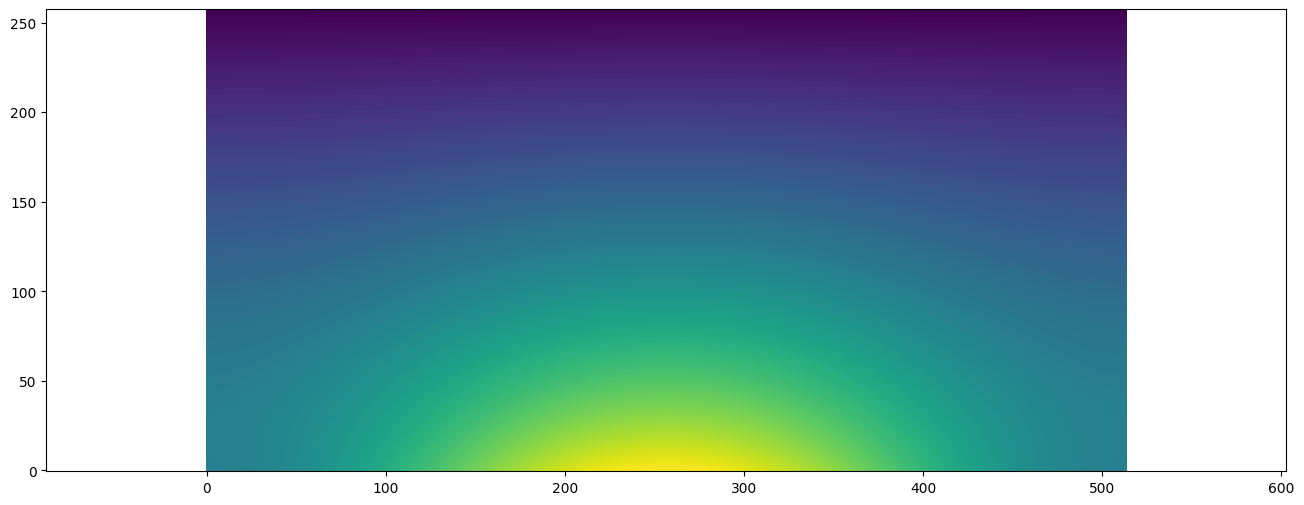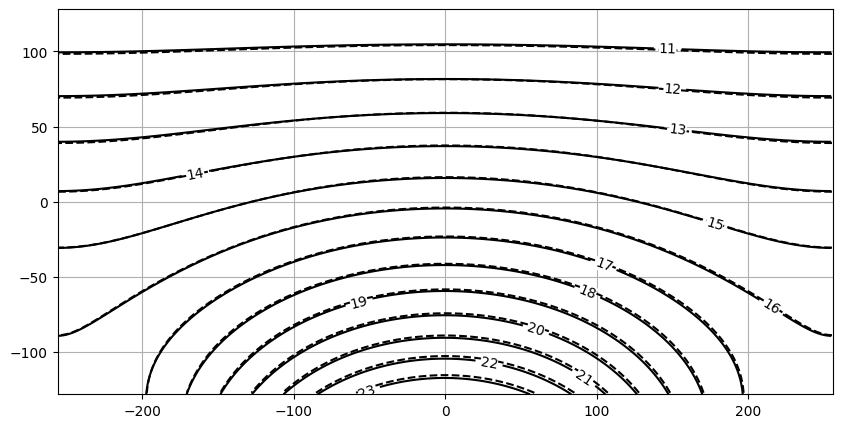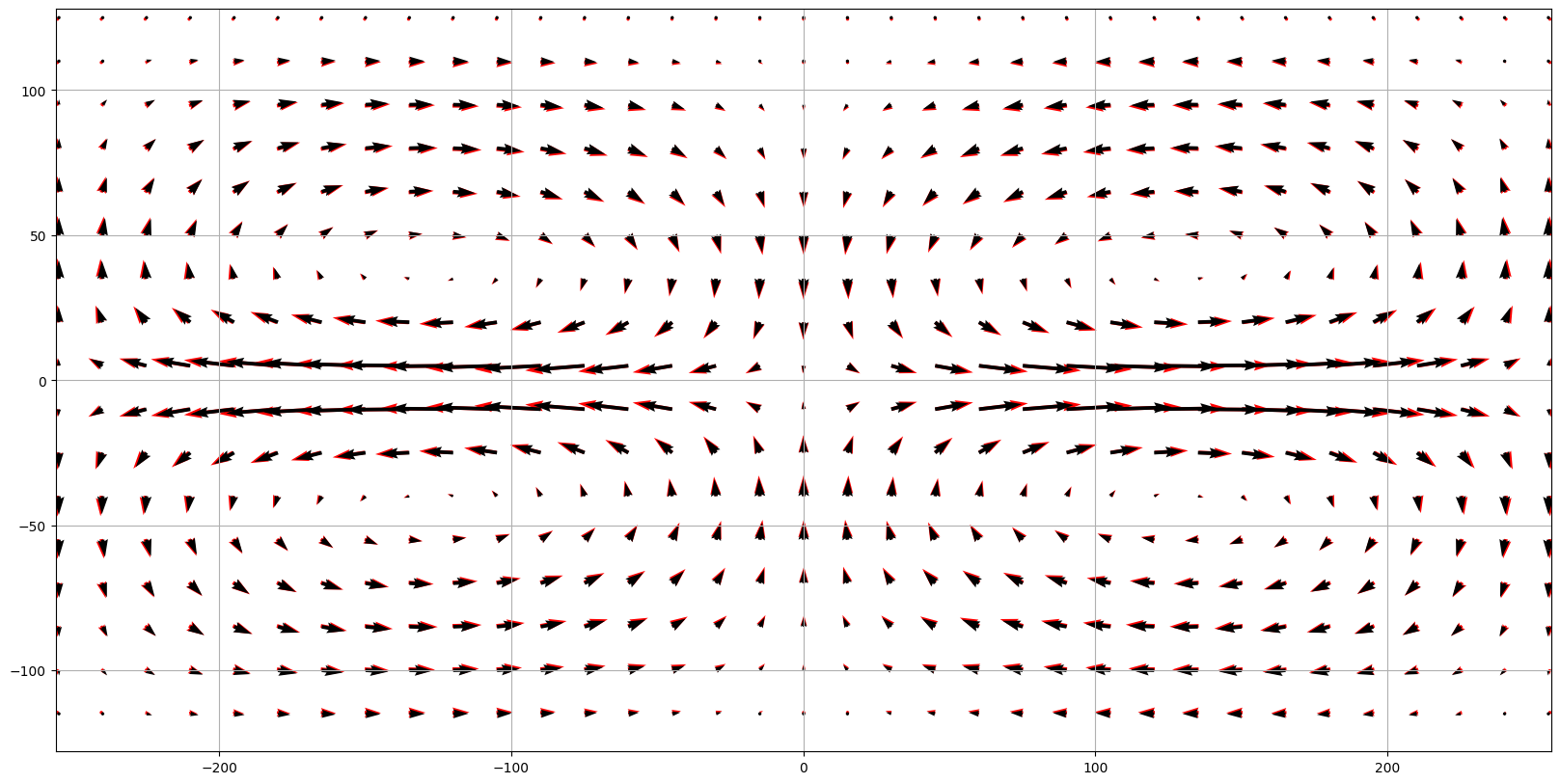Thermocapillary flows: 2D Planar heated channel¶
[1]:
from pystencils.session import *
from lbmpy.session import *
from pystencils.boundaries import BoundaryHandling
from lbmpy.phasefield_allen_cahn.analytical import analytical_solution_microchannel
from lbmpy.phasefield_allen_cahn.contact_angle import ContactAngle
from lbmpy.phasefield_allen_cahn.kernel_equations import *
from lbmpy.phasefield_allen_cahn.numerical_solver import get_runge_kutta_update_assignments
from lbmpy.phasefield_allen_cahn.parameter_calculation import calculate_parameters_rti, AllenCahnParameters
from lbmpy.advanced_streaming import LBMPeriodicityHandling
from lbmpy.boundaries import NoSlip, LatticeBoltzmannBoundaryHandling
If cupy is installed the simulation automatically runs on GPU
[2]:
try:
import cupy
except ImportError:
cupy = None
gpu = False
target = ps.Target.CPU
print('No cupy installed')
if cupy:
gpu = True
target = ps.Target.GPU
Overview¶
In this tutorial, we will provide an introduction to thermocapillary flows and solve an example setup using lbmpy and pystencils. This tutorial builds upon the conservative Allen-Cahn tutorial. Thus it is highly recommended to read mentioned tutorial first.
Thermocapillary flows refer to the motion of fluids induced by temperature gradients at liquid interfaces. They play a crucial role in various natural and industrial processes, such as microfluidics, materials processing, and the behavior of liquid droplets in microgravity environments.
In this tutorial the motion of fluid in a heated microchannel is investigated. This problem has been addressed by numerous authors for example here to verify thermocapillary flow models. The advantage of this problem is the existance of an analytical solution which is commonly very hard to find in these complex flow problems. Here, we will apply a second order accurate Runge Kutta scheme to solve the heat equation.
Geometry Setup¶
First of all the stencils for the phase-field LB step as well as the stencil for the hydrodynamic LB step are defined. According to the stencils the simulation runs either in 2D or 3D
[3]:
stencil_phase = LBStencil(Stencil.D2Q9)
stencil_hydro = LBStencil(Stencil.D2Q9)
Definition of the parameters used in this tutorial
[4]:
# domain
L0 = 256
domain_size = (2 * L0, L0)
# initial timesteps for the temperature solver
timesteps_temperature = 10000
# timesteps for the whole simulation
timesteps = 400000
# Parameters of the simulation
parameters = ThermocapillaryParameters(density_heavy=1.0, density_light=1.0,
dynamic_viscosity_heavy=0.2, dynamic_viscosity_light=0.2,
surface_tension=0.0,
heat_conductivity_heavy=0.2, heat_conductivity_light=0.2,
mobility=0.05, interface_thickness=4,
sigma_ref=0.025, sigma_t=-5e-4)
T_h = 20
T_c = 10
T_0 = 4
Note that the Parametes are defined in the ThermocapillaryParameters class. This has the advantage that the class defines for every parameter a symbolic representation. Thus, in the later derivation of the update rules only symbolic parameters occure and the numerical values will come as input parameters via parameters.symbolic_to_numeric_map.
[5]:
parameters
[5]:
| Name | SymPy Symbol | Value |
|---|---|---|
| Density heavy phase | $\rho_{H}$ | $1.0$ |
| Density light phase | $\rho_{L}$ | $1.0$ |
| Relaxation time heavy phase | $\tau_{H}$ | $0.6$ |
| Relaxation time light phase | $\tau_{L}$ | $0.6$ |
| Relaxation rate Allen Cahn LB | $\omega_{\phi}$ | $1.53846153846154$ |
| Gravitational acceleration | $F_{g}$ | $0.0$ |
| Interface thickness | $W$ | $4$ |
| Mobility | $M_{m}$ | $0.05$ |
| Surface tension | $\sigma$ | $0.0$ |
| Heat Conductivity Heavy | $\kappa_{H}$ | $0.2$ |
| Heat Conductivity Light | $\kappa_{L}$ | $0.2$ |
| Sigma Ref | $\sigma_{ref}$ | $0.025$ |
| Sigma T | $\sigma_{T}$ | $-0.0005$ |
| Temperature Ref | $T_{ref}$ | $0$ |
Fields¶
As a next step all fields which are needed get defined. To do so we create a datahandling object. More details about it can be found in the third tutorial of the pystencils framework. Basically it holds all fields and manages the kernel runs.
[6]:
# create a datahandling object
dh = ps.create_data_handling((domain_size), periodicity=(True, False), default_target=target)
# LBM PDF arrays
g = dh.add_array("g", values_per_cell=len(stencil_hydro))
dh.fill("g", 0.0, ghost_layers=True)
h = dh.add_array("h",values_per_cell=len(stencil_phase))
dh.fill("h", 0.0, ghost_layers=True)
g_tmp = dh.add_array("g_tmp", values_per_cell=len(stencil_hydro))
dh.fill("g_tmp", 0.0, ghost_layers=True)
h_tmp = dh.add_array("h_tmp",values_per_cell=len(stencil_phase))
dh.fill("h_tmp", 0.0, ghost_layers=True)
# velocity, phase-field and temperature array
u = dh.add_array("u", values_per_cell=dh.dim)
dh.fill("u", 0.0, ghost_layers=True)
C = dh.add_array("C")
dh.fill("C", 0.0, ghost_layers=True)
C_tmp = dh.add_array("C_tmp")
dh.fill("C_tmp", 0.0, ghost_layers=True)
temperature = dh.add_array("temperature")
dh.fill("temperature", T_c, ghost_layers=True)
# temporary array for the RK scheme
RK1 = dh.add_array("RK1")
dh.fill("RK1", 0.0, ghost_layers=True)
Parameter definition¶
The next step is to calculate all parameters which are needed for the simulation.
[7]:
# relaxation rate for the phase-field LBM step
w_c = 1.0/(0.5 + (3.0 * parameters.symbolic_mobility))
# relaxation rate for the hydrodynamic LBM step
omega = parameters.omega(C)
[8]:
# density for the whole domain
rho_L = parameters.symbolic_density_light
rho_H = parameters.symbolic_density_heavy
density = rho_L + C.center * (rho_H - rho_L)
Definition of the lattice Boltzmann methods¶
[9]:
config_phase = LBMConfig(stencil=stencil_phase, method=Method.CENTRAL_MOMENT,
compressible=True, zero_centered=False,
relaxation_rate=w_c,
force=sp.symbols(f"F_:{stencil_phase.D}"),
output={'density': C_tmp},
velocity_input=u)
method_phase = create_lb_method(config_phase)
method_phase
[9]:
| Central-Moment-Based Method | Stencil: D2Q9 | Zero-Centered Storage: ✗ | Force Model: Guo | ||
|---|---|---|---|---|---|
| Continuous Hydrodynamic Maxwellian Equilibrium | $f (\rho, \left( u_{0}, \ u_{1}\right), \left( v_{0}, \ v_{1}\right)) = \frac{3 \rho e^{- \frac{3 \left(- u_{0} + v_{0}\right)^{2}}{2} - \frac{3 \left(- u_{1} + v_{1}\right)^{2}}{2}}}{2 \pi}$ | ||
|---|---|---|---|
| Compressible: ✓ | Deviation Only: ✗ | Order: 2 | |
| Relaxation Info | ||
|---|---|---|
| Central Moment | Eq. Value | Relaxation Rate |
| $1$ | $\rho$ | $\frac{1.0}{3.0 M_{m} + 0.5}$ |
| $x$ | $0$ | $\frac{1.0}{3.0 M_{m} + 0.5}$ |
| $y$ | $0$ | $\frac{1.0}{3.0 M_{m} + 0.5}$ |
| $x y$ | $0$ | $\frac{1.0}{3.0 M_{m} + 0.5}$ |
| $x^{2} - y^{2}$ | $0$ | $\frac{1.0}{3.0 M_{m} + 0.5}$ |
| $x^{2} + y^{2}$ | $\frac{2 \rho}{3}$ | $1.0$ |
| $x^{2} y$ | $0$ | $1.0$ |
| $x y^{2}$ | $0$ | $1.0$ |
| $x^{2} y^{2}$ | $\frac{\rho}{9}$ | $1.0$ |
[10]:
config_hydro = LBMConfig(stencil=stencil_phase, method=Method.CENTRAL_MOMENT,
compressible=False,
force=sp.symbols(f"F_:{stencil_hydro.D}"),
output={'velocity': u},
relaxation_rates=[omega, omega, 1, 1])
method_hydro = create_lb_method(config_hydro)
method_hydro
[10]:
| Central-Moment-Based Method | Stencil: D2Q9 | Zero-Centered Storage: ✓ | Force Model: Guo | ||
|---|---|---|---|---|---|
| Continuous Hydrodynamic Maxwellian Equilibrium | $f (\rho, \left( u_{0}, \ u_{1}\right), \left( v_{0}, \ v_{1}\right)) = \frac{3 \delta_{\rho} e^{- \frac{3 v_{0}^{2}}{2} - \frac{3 v_{1}^{2}}{2}}}{2 \pi} + \frac{3 e^{- \frac{3 \left(- u_{0} + v_{0}\right)^{2}}{2} - \frac{3 \left(- u_{1} + v_{1}\right)^{2}}{2}}}{2 \pi}$ | ||
|---|---|---|---|
| Compressible: ✗ | Deviation Only: ✗ | Order: 2 | |
| Relaxation Info | ||
|---|---|---|
| Central Moment | Eq. Value | Relaxation Rate |
| $1$ | $\rho$ | $0.0$ |
| $x$ | $- \delta_{\rho} u_{0}$ | $0.0$ |
| $y$ | $- \delta_{\rho} u_{1}$ | $0.0$ |
| $x y$ | $\delta_{\rho} u_{0} u_{1}$ | $\frac{2}{2 {C}_{(0,0)} \left(\tau_{H} - \tau_{L}\right) + 2 \tau_{L} + 1}$ |
| $x^{2} - y^{2}$ | $\delta_{\rho} u_{0}^{2} - \delta_{\rho} u_{1}^{2}$ | $\frac{2}{2 {C}_{(0,0)} \left(\tau_{H} - \tau_{L}\right) + 2 \tau_{L} + 1}$ |
| $x^{2} + y^{2}$ | $\delta_{\rho} u_{0}^{2} + \delta_{\rho} u_{1}^{2} + \frac{2 \rho}{3}$ | $\frac{2}{2 {C}_{(0,0)} \left(\tau_{H} - \tau_{L}\right) + 2 \tau_{L} + 1}$ |
| $x^{2} y$ | $- \frac{\delta_{\rho} u_{1}}{3}$ | $1$ |
| $x y^{2}$ | $- \frac{\delta_{\rho} u_{0}}{3}$ | $1$ |
| $x^{2} y^{2}$ | $\frac{\delta_{\rho} u_{0}^{2}}{3} + \frac{\delta_{\rho} u_{1}^{2}}{3} + \frac{\rho}{9}$ | $1$ |
Initialization¶
[11]:
h_updates = initializer_kernel_phase_field_lb(method_phase, C, u, h, parameters)
g_updates = initializer_kernel_hydro_lb(method_hydro, 1.0, u, g)
h_init = ps.create_kernel(h_updates, target=dh.default_target, cpu_openmp=True).compile()
g_init = ps.create_kernel(g_updates, target=dh.default_target, cpu_openmp=True).compile()
Initialisation of the phase-field, as well as the temperature array
[12]:
# initialize the domain
def Initialize_distributions():
Nx = domain_size[0]
Ny = domain_size[1]
W = parameters.interface_thickness
for block in dh.iterate(ghost_layers=True, inner_ghost_layers=False):
x = np.zeros_like(block.midpoint_arrays[0])
x[:, :] = block.midpoint_arrays[0]
normalised_x = np.zeros_like(x[:, 0])
normalised_x[:] = x[:, 0] - L0
omega = np.pi / L0
# bottom wall
block["temperature"][:, 0] = T_h + T_0 * np.cos(omega * normalised_x)
# top wall
block["temperature"][:, -1] = T_c
y = np.zeros_like(block.midpoint_arrays[1])
y[:, :] = block.midpoint_arrays[1]
y += Ny // 2
init_values = 0.5 + 0.5 * np.tanh((y - Ny) / (W / 2))
block["C"][:, :] = init_values
block["C_tmp"][:, :] = init_values
if gpu:
dh.all_to_gpu()
dh.run_kernel(h_init, **parameters.symbolic_to_numeric_map)
dh.run_kernel(g_init)
[13]:
force_h = force_h = interface_tracking_force(C, stencil_phase, parameters)
hydro_force = hydrodynamic_force(C, method_hydro, parameters, body_force=[0, 0, 0],
temperature_field=temperature)
Definition of the LB update rules¶
[14]:
lbm_optimisation = LBMOptimisation(symbolic_field=h, symbolic_temporary_field=h_tmp)
allen_cahn_lb = create_lb_update_rule(lbm_config=config_phase,
lbm_optimisation=lbm_optimisation)
allen_cahn_lb = add_interface_tracking_force(allen_cahn_lb, force_h)
ast_allen_cahn_lb = ps.create_kernel(allen_cahn_lb, target=dh.default_target, cpu_openmp=True)
kernel_allen_cahn_lb = ast_allen_cahn_lb.compile()
[15]:
force_Assignments = hydrodynamic_force_assignments(u, C, method_hydro, parameters,
body_force=[0, 0, 0], temperature_field=temperature)
lbm_optimisation = LBMOptimisation(symbolic_field=g, symbolic_temporary_field=g_tmp)
hydro_lb_update_rule = create_lb_update_rule(lbm_config=config_hydro,
lbm_optimisation=lbm_optimisation)
hydro_lb_update_rule = add_hydrodynamic_force(hydro_lb_update_rule, force_Assignments, C, g,
parameters, config_hydro)
ast_hydro_lb = ps.create_kernel(hydro_lb_update_rule, target=dh.default_target, cpu_openmp=True)
kernel_hydro_lb = ast_hydro_lb.compile()
Setup of the RK scheme to solve the temperature¶
[16]:
a = get_runge_kutta_update_assignments(stencil_hydro, C, temperature, u, [RK1, ],
parameters.heat_conductivity_heavy,
parameters.heat_conductivity_light,
1.0, 1.0, density)
[17]:
init_RK = [ps.Assignment(RK1.center, temperature.center)]
init_RK_kernel = ps.create_kernel(init_RK, target=dh.default_target, cpu_openmp=True).compile()
[18]:
TempUpdate1_kernel = ps.create_kernel(a[0], target=dh.default_target, cpu_openmp=True).compile()
TempUpdate2_kernel = ps.create_kernel(a[1], target=dh.default_target, cpu_openmp=True).compile()
Boundary Conditions¶
[19]:
# periodic Boundarys for g, h and C
periodic_BC_C = dh.synchronization_function(C.name, target=dh.default_target, optimization = {"openmp": True})
periodic_BC_T = dh.synchronization_function(temperature.name, target=dh.default_target, optimization = {"openmp": True})
periodic_BC_g = LBMPeriodicityHandling(stencil=stencil_hydro, data_handling=dh, pdf_field_name=g.name,
streaming_pattern='pull')
periodic_BC_h = LBMPeriodicityHandling(stencil=stencil_phase, data_handling=dh, pdf_field_name=h.name,
streaming_pattern='pull')
# No slip boundary for the phasefield lbm
bh_allen_cahn = LatticeBoltzmannBoundaryHandling(method_phase, dh, 'h',
target=dh.default_target, name='boundary_handling_h',
streaming_pattern='pull')
# No slip boundary for the velocityfield lbm
bh_hydro = LatticeBoltzmannBoundaryHandling(method_hydro, dh, g.name,
target=dh.default_target, name='boundary_handling_g',
streaming_pattern='pull')
wall = NoSlip()
bh_allen_cahn.set_boundary(wall, make_slice[:, 0])
bh_allen_cahn.set_boundary(wall, make_slice[:, -1])
bh_hydro.set_boundary(wall, make_slice[:, 0])
bh_hydro.set_boundary(wall, make_slice[:, -1])
bh_allen_cahn.prepare()
bh_hydro.prepare()
Full timestep¶
[20]:
def temp_update():
dh.run_kernel(init_RK_kernel, **parameters.symbolic_to_numeric_map)
dh.run_kernel(TempUpdate1_kernel, **parameters.symbolic_to_numeric_map)
dh.run_kernel(TempUpdate2_kernel, **parameters.symbolic_to_numeric_map)
periodic_BC_T()
[21]:
# definition of the timestep for the immiscible fluids model
def timeloop():
# Solve the interface tracking LB step with boundary conditions
periodic_BC_h()
bh_allen_cahn()
dh.run_kernel(kernel_allen_cahn_lb, **parameters.symbolic_to_numeric_map)
# Solve the hydro LB step with boundary conditions
periodic_BC_g()
bh_hydro()
dh.run_kernel(kernel_hydro_lb, **parameters.symbolic_to_numeric_map)
dh.swap("C", "C_tmp")
# periodic BC of the phase-field
periodic_BC_C()
# Update the temperature field
temp_update()
# field swaps
dh.swap("h", "h_tmp")
dh.swap("g", "g_tmp")
[22]:
Initialize_distributions()
if 'is_test_run' not in globals():
for i in range(0, timesteps_temperature):
temp_update()
for i in range(0, timesteps + 1):
timeloop()
else:
timeloop()
[23]:
if 'is_test_run' not in globals():
if gpu:
dh.all_to_cpu()
plt.scalar_field(dh.cpu_arrays["C"])

[24]:
if 'is_test_run' not in globals():
plt.scalar_field(dh.cpu_arrays["temperature"])

[25]:
if 'is_test_run' not in globals():
nx = domain_size[0]
ny = domain_size[1]
myDatX = np.arange(nx)-L0
myDatY = np.arange(ny)-L0//2
XX, YY = np.meshgrid(myDatX, myDatY)
u_calc = dh.gather_array(u.name, ghost_layers=False)
[26]:
if 'is_test_run' not in globals():
k_h = parameters.heat_conductivity_heavy
k_l = parameters.heat_conductivity_light
sigma_T = parameters.sigma_t
mu_L = parameters.dynamic_viscosity_light
x, y, u_x, u_y, t_a = analytical_solution_microchannel(L0, nx, ny, k_h, k_l, T_h, T_c, T_0, sigma_T, mu_L)
[27]:
if 'is_test_run' not in globals():
fig, ax = plt.subplots()
fig.set_figheight(5)
fig.set_figwidth(10)
levels = range(11,24)
CS1 = ax.contour(x, y, t_a,linestyles='dashed', levels =levels, colors =['k'])
plt.grid()
CS2 = plt.contour(XX, YY, dh.gather_array(temperature.name, ghost_layers=False).T, levels =levels, colors =['k'])
clabels = ax.clabel(CS2, inline=1, fontsize=10,fmt='%2.0lf')
[txt.set_bbox(dict(facecolor='white', edgecolor='none', pad=0)) for txt in clabels]
plt.ylim((-128,128))
plt.xlim((-256,256))

[28]:
if 'is_test_run' not in globals():
fig1, ax = plt.subplots()
fig1.set_figheight(10)
fig1.set_figwidth(20)
excludeN = 15
CS1 = ax.quiver(x[::excludeN,::excludeN]+1.1, y[::excludeN,::excludeN]-2.5, u_x.T[::excludeN,::excludeN].T, u_y.T[::excludeN,::excludeN].T,
angles='xy', scale_units='xy', scale=0.00001, color='r')
CS1 = ax.quiver(XX[::excludeN,::excludeN]+1.1, YY[::excludeN,::excludeN]-2, u_calc[::excludeN,::excludeN, 0].T, u_calc[::excludeN,::excludeN, 1].T,
angles='xy', scale_units='xy', scale=0.00001)
plt.grid()
plt.ylim((-128,128))
plt.xlim((-256,256))
